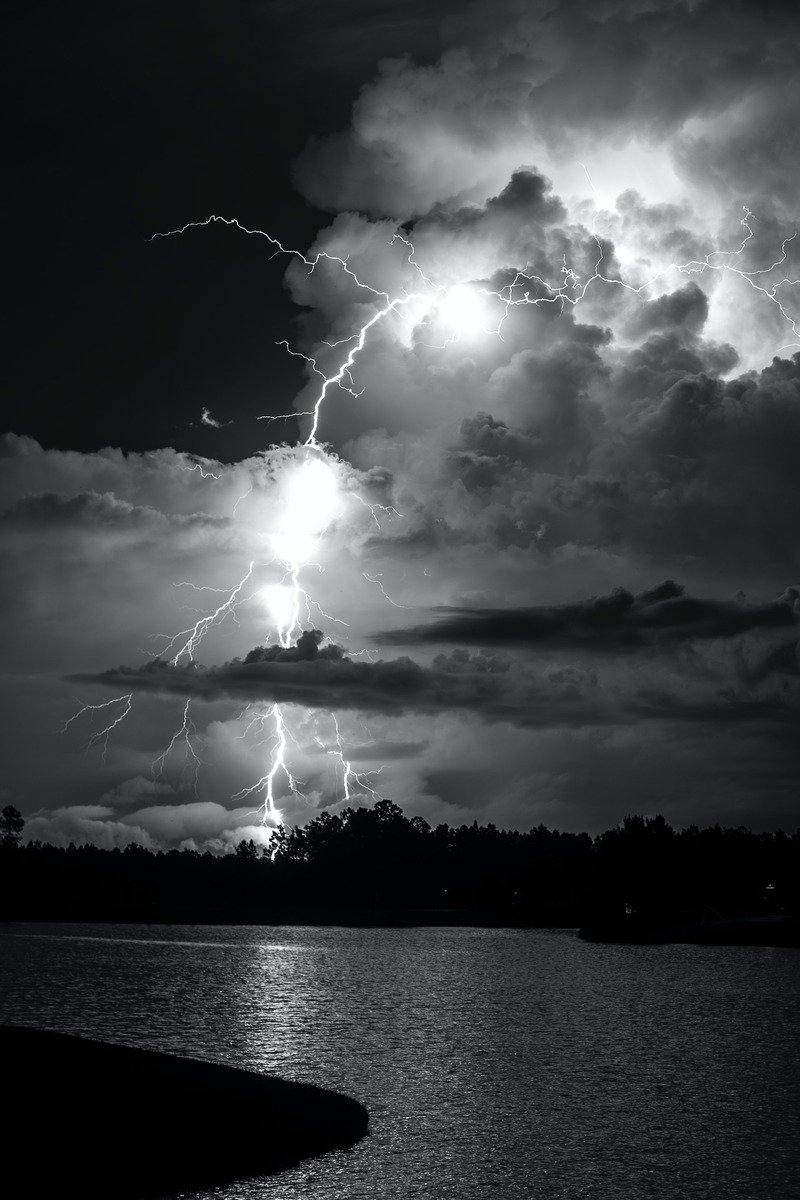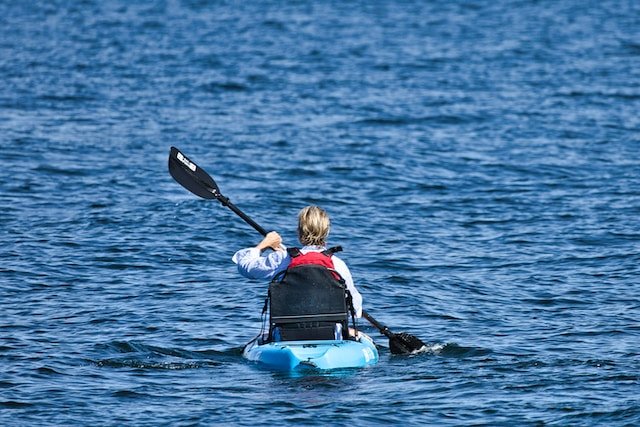How To Survive A Lightning Strike While Kayaking

Kayaking is one of your exciting go-to options for outdoor activity that allows enthusiasts to connect with nature while experiencing beautiful waterways. You might be gliding and relaxing through serene lakes, taking on challenging rapids, or just exploring the coasts, the feel and experience is unparalleled.
However, amidst all of your excitement, there are some potential risks that kayakers must be aware of. One such risk is the threat of lightning strikes. Lightning can strike with little to no warning, and can have devastating consequences for those on the water.
Hence, it’s essential to be informed about safety measures, especially when it comes to dealing with lightning strikes. Being caught in a thunderstorm while kayaking can be a life-threatening situation, and knowing how to handle it is crucial for your safety.
According to the National Oceanic and Atmospheric Administration (NOAA), lightning strikes are responsible for an average of 20 – 30 deaths and 100+ injuries annually in the United States. While there is no specific data on lightning strikes during kayaking, it’s essential to take these statistics seriously and prioritize safety measures when on the water.
How Lightning Is Formed
- Formation of Cumulonimbus Clouds: Lightning typically occurs during thunderstorms, which are often characterized by the towering of cumulonimbus clouds. These clouds develop due to the rapid updraft of warm, moist air meeting cooler air at higher altitudes.
- Positive and Negative Charges: Within these towering storm clouds, positive and negative charges become separated. The exact mechanism behind this charge separation is still a subject of scientific research but involves the collision and friction of water droplets and ice crystals.
- Lightning Strikes as a Discharge: When the charge separation becomes significant, it seeks to equalize, leading to the discharge of electricity in the form of lightning. This discharge can occur within the cloud itself or extend to the ground.
Types of Lightning
- Cloud-to-Cloud Lightning: Cloud-to-cloud lightning, as the name suggests, the lightning flashes stay within the clouds. While it may not directly impact kayakers, it serves as an indicator of the storm’s intensity and the potential for ground strikes.
- Cloud-to-Ground Lightning: Cloud-to-ground lightning is perhaps the most well-known type. It occurs when lightning discharges from the cloud and makes contact with the Earth’s surface. Kayakers are particularly vulnerable to this type of lightning when they are on open water.
One of the most challenging aspects of dealing with lightning is its speed and unpredictability. Lightning can travel at speeds of up to 220,000 miles per hour (354,000 kilometers per hour), making it difficult to react in time.
Thunder, which is the sound produced by lightning, travels at the speed of sound, which is significantly slower than lightning itself. This time gap between seeing the lightning and hearing the thunder can vary depending on your distance from the strike.
Responding to Lightning Strikes
During your kayaking trip, if you happen to be faced with the rare, but potentially life-threatening situation of a lightning strike, it’s essential to know how to respond effectively. If you find yourself caught in open water during a lightning storm, the below tips might come in handy.
- Maintain a Low Profile: Stay as low in your kayak as possible. Keep your body huddled down, reducing your exposure to lightning by minimizing your height.
- Dispersing Electrical Charge: To disperse electrical charge, avoid touching any metal components of your kayak or paddle. Keep your hands and feet away from the kayak’s metal parts, as they can act as conductors for lightning.
First Aid for Lightning Strike Victims
In the unfortunate event that someone in your group is struck by lightning, it is crucial to provide immediate first aid. Quickly assess the lightning strike victim for injuries. Check for signs of burns, loss of consciousness, or difficulty breathing.
If the lightning strike victim is unresponsive and not breathing, initiate CPR (Cardiopulmonary Resuscitation) immediately. If they are not breathing but still have a pulse, perform rescue breathing until professional medical help arrives.
Call for professional medical assistance as soon as possible. If you have an emergency communication device, use it to alert authorities and provide your exact location.
Responding to a lightning strike with speed and appropriate first aid measures can significantly improve the victim’s chances of recovery and survival. Remember to stay calm, prioritize the victim’s safety, and seek professional medical help promptly.
Lightning Safety Gear When Kayaking
- Helmets: While helmets are commonly associated with whitewater kayaking, they can provide protection during thunderstorms. In the event of a lightning strike, a helmet can reduce the risk of head injuries caused by falling debris or sudden jolts.
- Personal Flotation Devices (PFDs): Always wear a properly fitted PFD when kayaking. In the event of a lightning strike, a PFD can help keep you afloat, especially if you’re rendered unconscious.
- Paddles with Lightning Conductors: Some paddles are designed with lightning conductors to direct electrical currents away from you in case of a strike. While not foolproof, these paddles can offer an additional layer of safety.
- Emergency Communication Devices: Carry a waterproof emergency communication device such as a VHF radio or a satellite phone. These devices can be invaluable in calling for help if you find yourself in a dangerous lightning situation.
Lightning Safety Precautions
Monitor The Weather Forecasts
Before embarking on any kayaking trip, it is crucial to stay informed about weather conditions. Rely on trusted weather forecasting services or apps that provide real-time updates. Ensure the sources you choose are known for their accuracy in predicting thunderstorms and lightning.
Be able to identify the different types of thunderstorm warnings issued by meteorological agencies, such as severe thunderstorm watches and warnings. Take these warnings seriously and adjust your kayaking plans accordingly.
Catch The Early Warning Signs
Recognizing early warning signs of an approaching thunderstorm is vital for your safety. If you notice the skies darkening rapidly, it could be an indicator of an approaching storm. Start heading back to shore immediately if you see this sign.
If you hear distant thunder, it’s a clear indication that a storm is approaching. Lightning can strike even before the rain begins, so don’t wait until it’s pouring to take cover.
A sudden increase in wind intensity can be an early sign of an approaching thunderstorm. Winds can make kayaking challenging and dangerous during a storm, so be prepared to take action.
Choose The Right Location To Kayak
Selecting the appropriate location for your kayaking trip can significantly reduce the risk of encountering lightning. Plan your trip with access to safe launch and landing points in mind. These points should be easily reachable in case you need to seek shelter during a thunderstorm.
Stay away from open water areas and exposed shorelines when thunderstorms are in the forecast. Seek sheltered coves, inlets, or areas with natural cover to reduce your exposure to lightning.
While the risks of lightning strikes during kayaking should not be underestimated, they should not deter you from enjoying the sport.
By following our guidelines, using common sense and some good judgment, you can continue to enjoy the beauty of the water bodies around you while also prioritizing your safety and the safety of those around you.






